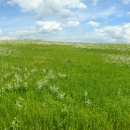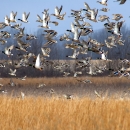What We Do
A vision statement is a concise statement of the planning unit’s desired future conditions based primarily on the Refuge System mission, specific Refuge purposes, the role of the planning unit in the landscape, and other mandates (602 FW 1, Exhibit 1).
The following vision for the District is a future-oriented statement designed to be achieved from management actions throughout the life of a Comprehensive Conservation Plan (CCP) and beyond:
The Charles M. Russell Wetland Management District, located in the heart of the Northern Great Plains, consists of Wildlife Refuges, Waterfowl Production Areas, and Conservation Easements. These mixed grassland, sagebrush sagebrush
The western United States’ sagebrush country encompasses over 175 million acres of public and private lands. The sagebrush landscape provides many benefits to our rural economies and communities, and it serves as crucial habitat for a diversity of wildlife, including the iconic greater sage-grouse and over 350 other species.
Learn more about sagebrush , and vital wetland habitats support abundant wildlife populations. In collaboration with partners, these habitats are managed to support the biological integrity of district lands and surrounding landscapes and provide a variety of recreational opportunities. Visitors enjoy a sense of serenity and wonder through the presence of diverse habitats and wildlife, connecting them with nature.
Management and Conservation
Refuges and Wetland Management Districts deploy a host of scientifically sound management tools to address biological challenges. These tools aim at ensuring a balanced conservation approach to benefit both wildlife and people. The Charles M. Russell Wetland Management District covers five counties in central Montana. It includes four unstaffed satellite Refuges and six Waterfowl Production Areas (WPAs). Management actions include prescribed fire, prescribed grazing, reseeding native forbs and grasses, and invasive species invasive species
An invasive species is any plant or animal that has spread or been introduced into a new area where they are, or could, cause harm to the environment, economy, or human, animal, or plant health. Their unwelcome presence can destroy ecosystems and cost millions of dollars.
Learn more about invasive species management.
Invasive Species:
Fortunately, most District lands are free from State listed noxious weeds and, when they occur, they are found in limited locations. The greatest impact to native prairie is invasive plants such as crested wheatgrass, smooth brome, Japanese brome, and cheatgrass. The State has not designated these plants as noxious since they do provide forage for cattle; however, they do not provide quality wildlife habitat.
State listed noxious weeds that have been documented on the District include Canada thistle, whitetop (hoary cress), leafy spurge, Russian knapweed, and houndstongue. Another invasive species of management concern is Russian olive. Although it is not listed as a noxious species in Montana, the State prohibited the sale of this tree in 2010. These trees provide perches for avian predators and fragment native grassland habitats making nesting birds more vulnerable to predators.
The Service manages invasive plant species through an Integrated Pest Management policy. This policy recommends a progressive effort of using mechanical, biological, cultural, and chemical means as necessary. Mechanical methods include plant removal by hand or with machinery - usually before plants form seeds.
Biological control involves the introduction of a plant’s natural enemy to kill the plant and reduce its spread. Release of beetles that feed on and eventually kill leafy spurge is an example of an effective biological control treatment used on the District. Chemical control uses approved chemicals suitable for killing noxious or other invasive plants while minimally harming other vegetation. Monitoring of invasive plant species and efforts to affect their populations and locations is important to prevent the establishment and spread of these species.
Grazing:
The northern Great Plains evolved over thousands of years through a complex ecological interaction between fire and grazing. Since the demise of wild bison in 1881, the fire–grazing interaction (which included intense herbivory after fire, long-distance movement, and years of abandonment) was replaced by constant grazing and no fire with the transition to ranches, fences, and livestock.
In the District, some satellite Refuges and Waterfowl Production Areas are grazed annually since their boundaries are not fenced; all other areas are prescriptively grazed. Prescriptive livestock grazing is the planned application of livestock grazing at a specified season, duration, and intensity to achieve specific vegetation objectives that are designed to meet the broader habitat and wildlife goals. Rather than managing Refuge resources to support livestock grazing or other economic uses, livestock grazing is used as a habitat management tool to achieve the goals and objectives for wildlife habitat. Under prescriptive grazing, an area is grazed as vegetation conditions warrant.
Although there are issues associated with livestock grazing, when prescriptive grazing is used with careful consideration of its compatibility with habitat and wildlife and other land management goals, it can be an effective tool. For example, it can be used to control invasive species, reduce ground litter, increase plant vigor or to accomplish other restoration and conservation objectives. Grazing can also be used where fire may be inappropriate, as in sage brush habitat. When applied correctly, it can address some of the challenges and issues of domestic grazing systems to create effective and ecologically beneficial results.
Prescribed Fire:
It is known that fire adversely affects the presence of fire-intolerant species such as big sagebrush sagebrush
The western United States’ sagebrush country encompasses over 175 million acres of public and private lands. The sagebrush landscape provides many benefits to our rural economies and communities, and it serves as crucial habitat for a diversity of wildlife, including the iconic greater sage-grouse and over 350 other species.
Learn more about sagebrush and Rocky Mountain juniper. However, fire stimulates fire tolerant plant species, returns nutrients to the soil, reduces residual cover, scarifies native seed, reduces or increases competition from invasive plants, restores upright structure structure
Something temporarily or permanently constructed, built, or placed; and constructed of natural or manufactured parts including, but not limited to, a building, shed, cabin, porch, bridge, walkway, stair steps, sign, landing, platform, dock, rack, fence, telecommunication device, antennae, fish cleaning table, satellite dish/mount, or well head.
Learn more about structure , and is a natural occurrence that District lands have evolved with over time. Following a fire, a more diverse native plant community returns, providing nesting and feeding habitat for some migratory birds and other wildlife.
Bird species native to northern mixed-grass prairie are well adapted to defoliation by fire. In general, decreases in species abundance and nesting density during the first growing season after prescribed burning are offset by increases in following years compared to pre-burn levels. The short-term unavailability of breeding habitat is outweighed by the long-term benefits from using prescribed fire to restore and maintain vegetation structure and to manage the fuel load by reducing accumulated litter and woody vegetation.
Nonetheless, care must be taken when using fire to manage grasslands in drier climates. The use of fire may have a negative vegetation response due to longer recovery periods attributed to reduced litter and soil moisture, increased evapotranspiration rates and solar radiation, less snow retention, and poorer water infiltration. Prescribed fire is generally not recommended in grasslands with sagebrush without very careful consideration of sage grouse habitat requirements as sagebrush is a fire intolerant species.
Wildfire occurrence on Service lands in the District is very minimal and records show only three fires in the last 20 years. Several prescribed fires have been conducted on the District to rejuvenate Dense Nesting Cover fields and burn slash piles associated with mechanical and chemical control of Russian olive trees on the Clark's Fork Waterfowl Production Area.
Farming:
Cooperative farming is used to convert newly-acquired cropland or Dense Nesting Cover fields to native grasslands or to replant decadent Dense Nesting Cover stands. Farming is time, equipment, and labor intensive; therefore, the District addresses this habitat need by working with local farmers to provide the equipment and perform this work. Farmers usually prepare the soil by tilling, use control measures to reduce or eliminate undesirable plants or weeds, plant a protective annual grain crop for 1–2 years, and finally plant grasses (Dense Nesting Cover or native species) into the remaining crop stubble.
Haying:
About 4,478 acres of District uplands had been cultivated by the previous landowner and were planted to Dense Nesting Cover after acquisition. Dense Nesting Cover usually consists of a mixture of intermediate, tall, pubescent, and western wheatgrass and alfalfa and yellow sweetclover. Dense Nesting Cover was likely selected as it is relatively easy to establish, less expensive than native prairie restoration, and provides valuable wildlife habitat.
Once established, Dense Nesting Cover fields must be rejuvenated every 5-10 years to maintain optimal nesting cover for migratory birds and optimal plant vigor. Dense Nesting Cover fields should be monitored for plant vigor and litter accumulation to determine when rejuvenation is needed. Haying is the most common technique for Dense Nesting Cover rejuvenation, followed by haying with field scarification, and prescribed burning. The average life expectancy of a Dense Nesting Cover field is approximately 10-15 years, before plant diversity has declined and it becomes necessary to re-establish it. Most Dense Nesting Cover fields in the District have been established for 20 or more years and are likely in need of rejuvenation, replanting, or conversion to native species.
Prescribed haying is also an excellent technique for control of annual or biannual invasive plant species in grasslands. Haying occurs prior to the seed production stage of the invasive species to prevent that years’ production of seed from germinating in the field, but also generally after most grassland nesting birds have completed nesting. Repeated haying or follow up with a chemical application may be needed.
Our Services
Within the District, we offer wildlife-dependent recreation opportunities such as hunting, wildlife observation, and photography. We also offer the following public services:
Our Projects and Research
Projects and research are used to improve scientific knowledge of natural resources and ecological processes to inform district management through monitoring and applied research.
The ever evolving and complex changes and threats to our natural resources and ecological processes make it necessary to constantly improve our scientific knowledge of the species and habitats we are entrusted to protect. Using a science-based approach of various research methodologies and inventories to continue to fill critical knowledge gaps will help us focus management on actions that have the greatest conservation benefit for the District’s priority habitats and species.
Law Enforcement
Federal Wildlife Officers promote the survival of species and health of the environment by ensuring that wildlife laws are followed. They also welcome visitors and are often the first U.S. Fish and Wildlife Service employees encountered by the public on Refuges and Wetland Management Districts. Federal Wildlife Officers are entrusted with protecting natural resources, visitors and employees on National Wildlife Refuge System lands.
Laws and Regulations
Management actions on National Wildlife Refuges and Waterfowl Production Areas within Wetland Management Districts are bound by mandates including laws, required regulations, and executive orders.

